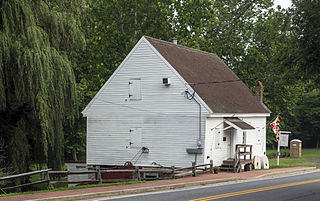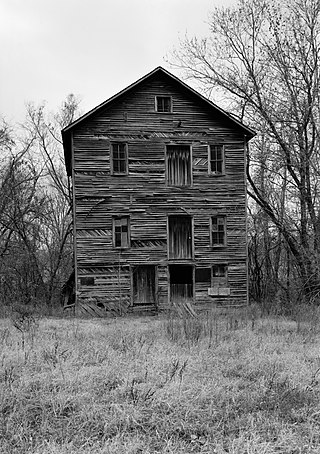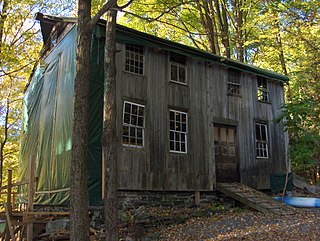
Wheeler County is a county located in the U.S. state of Texas. As of the 2020 census, its population was 4,990. Its county seat is Wheeler. The county was formed in 1876 and organized in 1879. It is named for Royall Tyler Wheeler, a chief justice of the Texas Supreme Court.

Roger Mills County is a county located in the western part of the U.S. state of Oklahoma. As of the 2020 census, the population was 3,442, making it the fourth-least populous county in Oklahoma. Its county seat is Cheyenne. The county was created in 1891.

Bale Grist Mill State Historic Park is a California state park located in Napa County between St. Helena and Calistoga. The park is the site of a water-powered grist mill that was built in 1846 is one of only two water-driven mills remaining west of the Mississippi River.

The Crystal Mill, or the Old Mill is an 1892 wooden powerhouse located on an outcrop above the Crystal River in Crystal, Colorado, United States. It is accessible from Marble, Colorado via four-wheel drive. Although called a Watermill, it is more correctly denoted as a compressor station, which used a water turbine to drive an air compressor, and was originally built with a horizontal wheel. The compressed air was then used to power other machinery or tools.

The Gilbert Stuart Birthplace and Museum is located in Saunderstown, Rhode Island. Gilbert Stuart was born on December 3, 1755, in the colonial-era house located on the property, becoming a famous American portraitist of the 18th and 19th centuries. The museum consists of the 1751 house in which Stuart was born, an operational snuff mill, an operational grist mill, a mill pond, streams, a fish ladder, 23 acres of nature trails, an herb garden, and a welcome center and art gallery containing paintings by both Gilbert Stuart and his daughter Jane Stuart..

The Marine Mill, established in 1839, was the first commercial sawmill in what became the U.S. state of Minnesota. Now in ruins, it is currently a historic site managed by the city of Marine on St. Croix in partnership with the Minnesota Historical Society. It was listed on the National Register of Historic Places as the Marine Mill Site in 1970 for having state-level significance in the themes of exploration/settlement, industry, and transportation. It was nominated for being the birthplace of the region's seminal industry—lumbering—and a major landing on its crucial transportation route, the St. Croix River. The site is also a contributing property to the Marine on St. Croix Historic District.

Beebe Windmill is a historic mill located at the southeast corner of Ocean Road and Hildreth Avenue in Bridgehampton, New York.

Shepherd's Mill is a gristmill in Shepherdstown, West Virginia, located on Town Run just as it descends to the Potomac River. The mill was built some time prior to 1739 by Thomas Shepherd, Sr. (1705-1776) — founder and namesake of the town — as a two-story structure. The original millwheel was probably a wood overshot wheel. The present 40-foot-diameter (12 m) Fitz Water Wheel Company steel overshot wheel was built in 1894; with the addition of a third story in the late 19th century, the mill is more representative of that era.

The Dillard Mill State Historic Site is a privately owned, state-administered property on Huzzah Creek in Crawford County, Missouri, that preserves a water-powered gristmill. The 132-acre (53 ha) site has been operated as a state historic site by the Missouri Department of Natural Resources under a lease agreement with the L-A-D Foundation since 1975. The site was listed on the National Register of Historic Places in 2015.

The Wye Mill is the oldest continuously operated grist mill in the United States, located at Wye Mills, Queen Anne's County and Talbot County, Maryland, United States. It is the earliest industrial site on the Eastern Shore in continuous use; dating to the late 17th century. It is a wood-frame, water-powered grist mill, with a 19th-century 26 HP 10-foot-diameter (3.0 m) Fitz steel overshot wheel. The mill retains nearly all of its late-18th-century equipment. The Wye Mill was one of the first grist mills to be automated with the Oliver Evans process, which is still in use today.

This is a list of the National Register of Historic Places listings in Roger Mills County, Oklahoma.

The Hildebrand Mill on Flint Creek in Colcord, Delaware County, Oklahoma was built c. 1845 and served hill people of the Old Cherokee Nation territory for more than 125 years. It is located not far from Siloam Springs, Arkansas. It was listed on the National Register of Historic Places in 1972.

The Water MillMuseum is a historic water mill and local history museum located at 41 Old Mill Road, Water Mill in Suffolk County, New York, USA. It is a 2-story, heavy wood-frame structure with a wood-shingle exterior and composed of two building sections. There is a 2-story, square-shaped main section and 1-story, one-bay wing. Attached to the rear is a 2+1⁄2-story tower and 1-story glassed-in porch. The mill structure dates to the mid-17th century. It operated as a mill until the early 20th century. It is now a local museum.

Wallace-Cross Mill is a historic grist mill located at East Hopewell Township, York County, Pennsylvania. It was built in 1826, and is a 2 1/2-story, frame building on a stone foundation. It has a gable roof with decorative bargeboard. It has an 11 feet in diameter, 4 feet wide, steel water wheel to run the machinery. The mill was given to York County by its owner in 1979.

The Kirks Mills Historic District is a national historic district that is located in Little Britain Township, Lancaster County, Pennsylvania, United States.

The Winooski Falls Mill District is located along the Winooski River in the cities of Winooski and Burlington, Vermont, in the United States of America. It encompasses a major industrial area that developed around two sets of falls on the river in the 19th century.

The Nathan Cooper Gristmill is a historic gristmill on the Black River located at 66 NJ Route 24 in Chester Township, Morris County, New Jersey. It was added to the National Register of Historic Places on November 21, 1976 for its significance in industry.
The Wheeler No. 1 Oil Well was the first well drilled in the Drumright-Cushing Oil Field of northeast Oklahoma, near Drumright. The success of the well, drilled in 1912 by Thomas Baker Slick, Sr., led to the development of the Cushing field and gave impetus to the early development of Oklahoma oilfields. The Drumright-Cushing field would go on to produce 310,000 barrels of oil a day at its peak in May 1917. The well made Slick's name as "King of the Wildcatters".

The Cushing Oil Field, also known as the Cushing-Drumright Oil Field, is an oil field in northeastern Oklahoma, part of the Mid-Continent oil province. The 10-mile (16 km) by 3-mile (4.8 km) field includes southeastern Payne County, northwestern Creek County, and northeastern Lincoln County. Named for its primary supply center at Cushing, Oklahoma, the field was developed from 1912.

Gillette's Grist Mill is a historic grist mill on Maple Hollow Road in New Hartford, Connecticut. Probably built in the mid-19th century, it is an extremely rare example of a grist mill with a surviving water wheel. The mill property was added to the National Register of Historic Places in 1977.





















